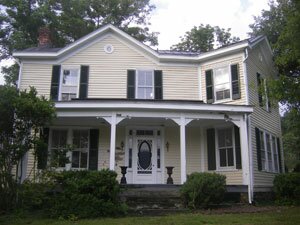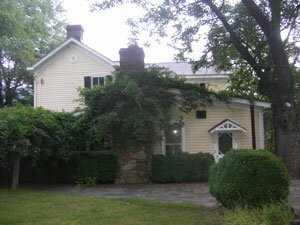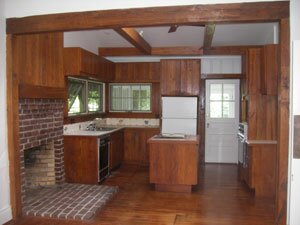REAL ESTATE- ON THE BLOCK- Faded glory: Help Greenway Farm to glow again

PHOTO BY ROSALIND WARFIELD-BROWN
ADDRESS: 340 Greenway Farm Place
NEIGHBORHOOD: Afton
ASKING: $1,095,000
ASSESSMENT: $1,257,200 ($930,000 under land use)
YEAR BUILT: 1876
SIZE: 2,794 fin. sq. ft., 150 unfin.
LAND: 21 acres
CURB APPEAL: 8 out of 10
AGENT: Ross Stevens, Stevens & Company 981-5268 (c)
When former Wahoo Edgar Allan Poe eulogized "the glory that was Greece/And the grandeur that was Rome," he wasn't talking about Greenway Farm, but his lines came to mind as we toured the place at the foot of Afton mountain. Beneath the sad dilapidations worked by the ravages of time, it's not hard to imagine the grandeur and glory of the farm in its heyday.
Fortunately, not all the grandeur has been lost: boxwoods that rival any we've seen are the heart of impressive landscaping: a semi-circle of huge ones makes an almost private outdoor room of the large front yard, more of them surround the rear patio, and a Williamsburg-like garden of them is a traditional counterpoint to a modern swimming pool and hot tub in the side yard.
A classy slate patio around the back of the house and under a vine-covered pergola is another remnant of grander days. Several outbuildings– a cottage with steep front steps on a rise high above the main house, what looks like a former servant's quarters with pretty fireplace, and a strange utility building that might once have housed chickens except it's so fancy– have all been recently painted to match the soothing cream of the main house. Together with a five-stall red horse barn, they create the impression of a well-maintained, cohesive little compound.
(There's another dependency: a strange adaptation of an old granary into a glass-walled '60s hippy pad complete with groovy built-in futon frame facing a massive stone chimney/fireplace, a big carpeted loft with track lighting, octagonal windows mirroring an octagonal cut-out above the futon frame– well, perhaps "the glory that was Haight-Ashbury/The grandeur that was Woodstock" says it best.)
Inside the house is a different story. Beginning on the crumbling front porch and moving right into the wide front hall, problems abound. The hardwood floors– probably heart pine, judging from the date the house was built– vary in width and condition, but like so much else here, are of such intrinsic quality that it's not hard– in fact, it's thrilling in a way– to imagine them refinished and glowing.
The same is true of two sizable hexagonal rooms, one over the other, to the right of the large center stairway. The room on the first floor has white panelling instead of plaster walls, reminiscent of New England houses of the same vintage. It's easy to imagine a rich Turkey carpet and deep leather couch in front of the fireplace. Here as in all the rooms (except the remodeled kitchen), large two-over-two windows let in lots of light. (The identical room above is the master bedroom with an adjoining small bath.)
Behind this is a room of indeterminate use– perhaps it could be an office or sewing nook, but what it was originally is unclear. Almost orphaned at the end of the downstairs hall and right next to a full bath, it could possibly become a private guest room.
On the other side of the stairway, a large living room with another fireplace, the same great windows, and a door to the pool and hot tub, leads to the weakest link in the house: the kitchen and breakfast area. While it's a large space spanning the entire back of the house, and with views to the gorgeous landscaping and big hill beyond, a 1973 renovation (maybe at the same time the swingin' pad was created) seems to have obliterated all traces of anything original.
It's dark, with exposed beams, dark paneling, and deep cherry/brown cabinets too high above windows and refrigerator for non-giants to reach. A skylight (completely out of place), crank-out windows, and a center island with jarring pink tile add insult to injury. A pretty brick fireplace with huge hearth does what it can to add some class, but it's fighting an uphill battle.
The house's recent history is as demoralizing in its way as the physical state of the place. According to the agent, an investor group bought the huge original farm, sold off the raw land and carved off this stately farmhouse compound to be the retirement home of one of the members. When his plans changed, the house was left to fend for itself, and the result has not been happy.
Considering that the roof is sketchy, the furnace must be replaced (estimates are available), much of the weatherboarding is coming loose, and the kitchen and baths have to be completely redone, the place doesn't seem to have much appeal.
But the stunning boxwoods and other landscaping, the pool, the location (privacy, mountain views, sweeping fields), the big stalls for horses, and the potential for rental income go a long way to offsetting the drawbacks.
In the end, however, it's the quality of the workmanship in the house- wide pine floors, 10-foot ceilings, fireplaces, beautiful paneling, molding, solid doors, pretty windows– that will win a new buyer's heart and encourage him or her to throw caution and money to the wind to recreate the former glory of Greenway Farm.


PHOTOS BY ROSALIND WARFIELD-BROWN
Each week, a brave local seller invites the Hook to provide an impartial, warts-and-all look at their real estate listing. E-mail yours today!
#
1 comment
"The hardwood floors-- probably heart pine, judging from the date the house was built?" Can you really be so ignorant that you don't know heart pine when you see it, and moreover to not know it is in fact a softwood? What on earth are you doing writing this column if you don't have a clue about such basic things? I'm wondering now how many sides the room you describe as "hexagonal" has. You have no credibility what-so-ever.